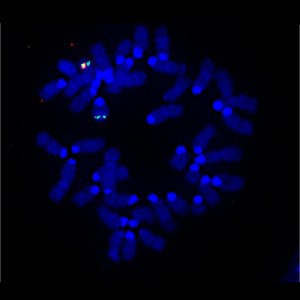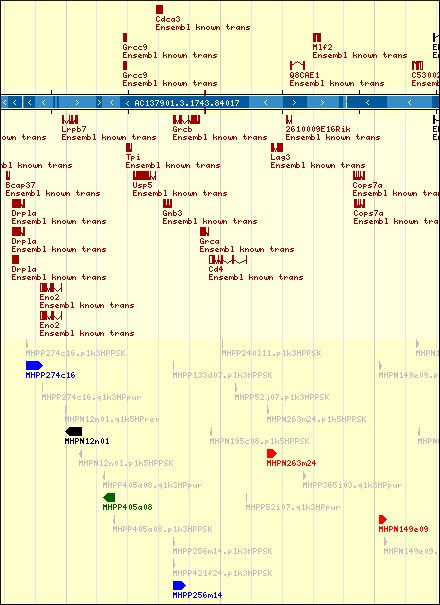MICER: a resource to help understand disease
 With the sequencing of the mouse genome at The Wellcome Trust Sanger Institute and other centres nearing completion, an extensive and increasingly accurate catalogue of mouse genes is available. The mouse gene set will work to help us understand the function of human genes in health and disease.
With the sequencing of the mouse genome at The Wellcome Trust Sanger Institute and other centres nearing completion, an extensive and increasingly accurate catalogue of mouse genes is available. The mouse gene set will work to help us understand the function of human genes in health and disease.
A major route to understanding how genes work is to study the effects of mutations in which the gene is disrupted. Although several methods are available to produce mutations in the mouse genome, new methods are needed to alter genes in a high-throughput manner.
MICER (Mutagenic Insertion and Chromosome Engineering Resource) – detailed in Nature Genetics online today (4 July 2004) – is a novel tool for targeted modification of the mouse genome. It is based on the mouse genome sequence: randomly defined sections of the mouse genome have been joined to a DNA molecule that can disrupt normal gene activity. When introduced into mouse cells, the mouse sequence in this molecule will often find its corresponding sequence in the genome and disrupt it.
“This is a tool that will allow researchers to exploit the high-quality genome sequence produced by the Mouse Genome Sequencing Consortium. We believe it will make a real difference to our understanding of the workings of genes in health and disease.”
Dr David Adams Leader of the MICER Project at The Wellcome Trust Sanger Institute
MICER dramatically reduces the time to go from a DNA region implicated in disease to modelling and understanding that disease. It allows researchers to modify one gene at a time, to produce duplications of genes or regions or to delete genes or regions. All these techniques are crucial for turning genomic information into health benefit.
“Delivery of high-quality genome sequences is only the first step towards improving human health. With these first steps, we can now move to developing entirely new ways of investigating genetic activity and the part that genes play in health and disease. MICER will help biomedical research to move more quickly towards that new understanding.”
Professor Allan Bradley Director of the Wellcome Trust Sanger Institute

The resource is freely available and the team are developing cell lines with vectors targeted to selected regions of the genome. The saving in research time is remarkable: in minutes, a researcher can identify and source reagents that would take weeks or months to make in the lab.
The team are now making a new set of cloned DNAs to target a larger proportion of genes: this phase is expected to be completed within 12 months.
But MICER, available as it has been developed, has already been put to use. James R. Lupski, Cullen Professor of Molecular and Human Genetics and Professor of Pediatrics at Baylor College of Medicine, has used MICER to engineer mouse models for genomic disorders (diseases due to rearrangements of the human genome).
“MICER combines the awesome power of bioinformatics and genomics with ‘wet-bench’ biology, enabling high-throughput, experimental-based functional genomics.”
James R. Lupski Cullen Professor of Molecular and Human Genetics and Professor of Pediatrics at Baylor College of Medicine
MICER complements other resources announced in the past two months by the Sanger Institute: the Sanger Institute Gene Trap Resource (SIGTR) provides a set of mutations in identified genes and a new approach announced on 23 June 2004 provides a novel method to mutate both copies of a gene. Freely available resources such as MICER and SIGTR will help to improve efficiencies in modelling disease.
The Sanger Institute, with its expertise in high-throughput biology and DNA sequencing is well placed to provide these resources for the biomedical community. These advances will make it easier for scientists to overcome the first hurdle in designing their experiment and ultimately this will accelerate the discovery process.
More information
Participants
- MICER
http://www.lifesciences.sourcebioscience.com/clone-products/mammalian/genomic-clones-others/sanger-resources/micer-mutagenic-insertion-and-chromosome-engineering-resource/ (updated) - The Netherlands Cancer Institute
http://www.nki.nl/ - Molecular and Human Genetics, Baylor College of Medicine
http://imgen.bcm.tmc.edu/molgen/
Utilities
- Ensembl genome browser (Mouse)
http://www.ensembl.org/Mus_musculus/
Publication details
Senior authors – David Adams and Allan Bradley
Publications:
Selected websites
The Wellcome Trust Sanger Institute
The Wellcome Trust Sanger Institute, which receives the majority of its funding from the Wellcome Trust, was founded in 1992. The Institute is responsible for the completion of the sequence of approximately one-third of the human genome as well as genomes of model organisms and more than 90 pathogen genomes. In October 2006, new funding was awarded by the Wellcome Trust to exploit the wealth of genome data now available to answer important questions about health and disease.
The Wellcome Trust and Its Founder
The Wellcome Trust is the most diverse biomedical research charity in the world, spending about £450 million every year both in the UK and internationally to support and promote research that will improve the health of humans and animals. The Trust was established under the will of Sir Henry Wellcome, and is funded from a private endowment, which is managed with long-term stability and growth in mind.


